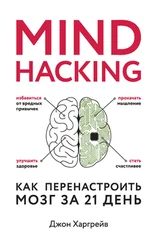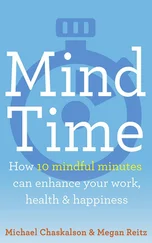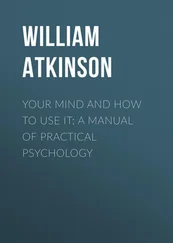There are many variations on the basic concentration game to keep it interesting, but my strong recommendation is to decide beforehand which variation you will play . The temptation will be to switch to a new variation mid-practice, which is a subtle trick your mind will play to amuse itself. Pick one and stick with it.
• The Illuminati.Instead of focusing on the nostrils, focus on the point between the eyebrows.
• Alien Blaster.Pretend each thought is an alien. Focus on your breath while remaining vigilant for stray aliens breaking through your defense shield. Whenever you see a thought arising, mentally say, Thought , which disintegrates the alien with a hydrogen-ion particle blaster.
• The Third Nipple.Instead of focusing on the nostrils, focus on the point between the breasts.
• Golden Breath.Instead of focusing on the nostrils, focus on the air itself as you inhale and exhale. Imagine that you are taking in pure oxygen, a delicious smell, or a healing elixir.
• The Slow Jam.Do the basic concentration game, but as you exhale, try to capture the “feel” of sinking into a warm bubble bath, relaxing into a sexy rhythm, or grooving to a slow jam.
• Rise and Smile.Perform any of the variations above, but smile while doing so. (See more on the scientific value of smiling in Section 3.2.)
There are also variations of this game that you can play during the day. In my experience, there’s no substitute for dedicated concentration practice, but these are excellent mini-games to hone your concentration skills throughout the day. Count +1 awareness point each time you catch your mind wandering, and remember to get back into the game.
• Single Threading.Take any mundane activity, from walking the dog to tying your shoes, and “slow down” your thought process to focus on each moment of the experience: a “single thread” of attention on the task at hand.
• Go with the Flow.At any point throughout the day, become aware of the “flow” of sensory input flowing into your mind, the stream of unbroken thoughts and sensation. See how long you can observe the “flow” and not get lost in it.
• The Proton Pack.Pretend that you’re a Ghostbuster and pay attention to the “stream” of your attention as it spews outward. Watch where you’re aiming it and see how long you can visualize that stream. Busting makes you feel good.
As you play these concentration games, you may find that habitual thoughts, memories, or emotions keep popping up. You might even have deep insights or realizations about your life, your personality, or your childhood history. This is normal . What you are seeing is the areas that need to be reprogrammed. You’re becoming aware of your own mental code.
The trick is to mentally note these things and tell your mind you will process them later. Avoid the temptation to get lost in another “mind movie.” As if you were training a child, gently say to your mind, That’s interesting, but we’re going to focus on the breath now . After your practice, write down any insights or observations on your practice sheet. You can always discuss them with your therapist later.
Above all, try to be gentle but firm with your mind. You may get frustrated when you notice your mind wandering, but remember: the act of noticing is the very sign of progress! Resist the urge to get angry or impatient with yourself; this is just more mind movie. Develop the habit of completely letting it go. The attitude is one of nonresistance: Gently set the mind back on your object of concentration and begin again. This is why we call it “practice.”
As we diligently practice these games, we develop clarity of mind and a sense of its underlying codebase. We also develop the precision necessary to analyze the code that runs our mind. This is the aspect of mind hacking we’ll talk about next.
[1.4]
“You need to learn how to select your thoughts just the same way you select your clothes every day. This is a power you can cultivate. If you want to control things in your life so bad, work on the mind. That’s the only thing you should be trying to control.”
—Elizabeth Gilbert 1
When personal computers first came on the scene, every department store had a computer section with the latest models on display: the Apple II, the Commodore 64, the Atari 800. Most of these computers came installed with BASIC, the language that allowed anyone to learn how to code.
As a young nerd, I had an expert level of BASIC (oxymoron), but I had a friend with almost zero knowledge. He knew how to write exactly one program. He was a bit of a prankster, and would have me watch out for salesclerks while he wrote his one program on all the computers in the store:
10 PRINT “I AM THE WORLD’S GREATEST HACKER”
20 GOTO 10
Running this program would cause the computer to endlessly display the words “I AM THE WORLD’S GREATEST HACKER,” an infinitely repeating testament to his mighty programming prowess.
My friend had mastered the loop, which is one of the essential building blocks of computer programming. When we’re writing software, loops are how we get stuff done. More than that, loops help us get stuff done efficiently . Loops are a shortcut. Sure, we could write:
x=1;
x=2;
x=3;
x=4;
x=5;
until our program was 1,000 lines long and all we had done was count to 1,000. Or we could just write:
for(x=1;x<=1000;x++)
which accomplishes the same thing, in one elegant line of code.
We have counting loops, which run through a set of instructions a defined number of times (“For every row in this spreadsheet, apply this formatting”). We have conditional loops, which run through a set of instructions if certain criteria are true (“Each minute, check if the time is 12:00, and if it is, pop up an alert”). We have infinite loops, which even my friend understood.
The complexity of modern software is mind-boggling: layers upon layers of loops. Say you’re reading this on an electronic device. The highest-level programming loops may tell your device what content to display and how to display it. Underneath that are loops running the reader app itself. Go deeper and you’ll find loops controlling the operating system that runs the apps. Still lower are loops running the device itself: the battery, the clock, the screen. The layers build on top of each other, growing increasingly sophisticated, and increasingly amazing .
When you’re using a word processor, making a phone call, or playing a video game, you don’t notice the loops. The loops are forming a higher-level, abstract representation that seems utterly divorced from the programming going on behind the scenes. All the richly complex software that we take for granted is run on top of simple building blocks like loops. It’s one of the most amazing things about computers . . . and our minds.
Our Minds Are Loopy
Like software, our minds are also programmed with loops.
Think back to how useless we were as babies. It’s as if our parents got a new computer, except there was nothing installed on it, not even an operating system. Turn it on, and all they got was some low-level configuration menu that told the newborn how to suck, cry, and poop.
Over the next six months, we learned some basic skills: sensory input, rudimentary cause and effect, the beginning of language, and some simple emotions. Whether we discovered it through trial and error, parental guidance, or luck, this programming “stuck” through simple repetition, through practicing these fundamental skills over and over.
Читать дальше
![Джон Харгрейв Mind Hacking [How to Change Your Mind for Good in 21 Days] обложка книги](/books/404192/dzhon-hargrejv-mind-hacking-how-to-change-your-min-cover.webp)











